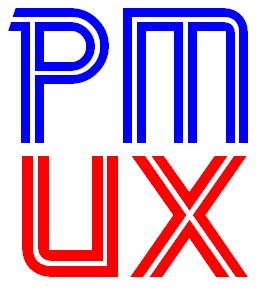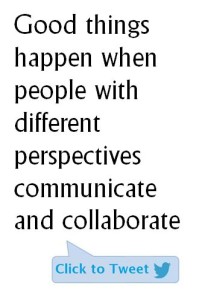By Saeed Khan and Heather Searl
 In a recent post Saeed mentioned the potential overlap of some responsibilities between Product Management and User Experience and Heather touched on the subject in her post Dear Product Manager: 4 Things Your UX Expert Wants You To Know
In a recent post Saeed mentioned the potential overlap of some responsibilities between Product Management and User Experience and Heather touched on the subject in her post Dear Product Manager: 4 Things Your UX Expert Wants You To Know
So we thought it might be interesting for the two of us to have a conversation about how we view the roles of Product Management and User Experience in relation to each other and the rest of the organization.
Our conversation ranged over a variety of topics that we’ll share in a couple in upcoming posts. To start, here is our conversation about the roles of Product Management and User Experience.
Working with other teams
Saeed: As a Product Manager I work with Marketing on how we present and position the product, I work with Sales, I work with Finance on pricing and I work with Services and Support. Do you see User Experience (UX) as cross functional, meaning that UX needs to work with a lot of different teams?
Heather: I think UX primarily needs to work with Product Management and the extended Development team. That includes tech writers, testers, et cetera. There are times we need input from Sales and Marketing but that generally needs to be filtered through Product Management to ensure the project doesn’t go down a tangent based on the agenda of another team or person.
Organizational Structures
Saeed: Some companies don’t understand how to manage and structure Product Management and UX. i.e. where should UX report? Do they report to Product Management? Report to Engineering? A separate entity on their own?
In my current organization both Product Management, and Product Marketing report to the Chief Product Officer (CPO). UX reports into the CTO, who reports into the CPO. And of course Engineering reports up into the CPO. In effect, we have 3 parallel groups who are peers on the org chart. This is healthy because it means there is no positional authority one group can use as leverage on the other when making decisions.
Heather: That reminds me of one company I worked for where the executives called UX the third leg of the stool. Product Management and Marketing were one leg, Engineering another and UX the third. UX would end up negotiating between Product Managers and Engineering. This happened in part because UX had to speak the language of both groups but they don’t always speak each other’s language. I don’t think that is the right role for UX.
I think that Product Management should be an umbrella that oversees the product. They set the vision, they oversee most things.
In my ideal world I would be 100% user focused. I’d think just about the customer experience, workflow and usability. It would be the Product Manager who had to juggle my ideas with budget and timelines and everything else. He or she says, “Yah that sounds great but it’s going to take an extra six months and we need to meet release deadlines, so we’re only going to do this part of what you are suggesting.”
However, I’ve worked with a lot of User Experience professionals who would disagree with this. They sometimes fail to recognize the realities of the business and want everything to be user focused.
Working with each other
 Saeed: I try to be very user focused. Right now we are working on defining a major release and the UX engineer is trying to work through various constraints from his side including UX guidelines, UI architecture requirements etc.
Saeed: I try to be very user focused. Right now we are working on defining a major release and the UX engineer is trying to work through various constraints from his side including UX guidelines, UI architecture requirements etc.
What I like about him is that he understands the constraints and we make rational decisions together. What I like about the teams I work with is that we (usually) all make rational decisions. Things fall apart when a team becomes obstinate and can’t or won’t budge from what they want to do.
While the organizational structure does matter, everyone being rational is what really matters. When everyone can talk and make reasonable decisions it works. We always face constraints and everyone has to play give and get. I’d love to have everything my way, but what I’ve found is that my way isn’t always 100% the best way. Good things happen when people with different perspectives communicate and collaborate.
Heather: I’ve been caught between both Engineering and Product Management. I’ve worked with developers that say what the User Experience team wants is impossible and then I have to start Googling to come back to them with solutions. I don’t think I should have to show developers that other people have solved their problem already to move things forward. I doubt they like it either.
I’ve also worked with Product Managers who say “It will look like this, and must work like this,” and I’m constantly saying “What about…” and, “It would be easier like this.” I don’t feel I add any value to a project when a Product Manager wants everything their way.
But there are also Product Managers who don’t make decisions and say, “Go work it out with the developers,” or won’t set a vision or overall goal for a project or release. Everyone ends up following their own agenda, and I would imagine the Product Manager ends up wondering why he/she didn’t get a solid product on time.
I guess I’m saying that I agree with you. As long as everyone is working as a team and open it works well. But that team needs a leader and I see that as the Product Manager.
Saeed: Sadly, I’ve met PMs like the ones you describe. A PM who can’t or won’t make decisions should quit and find another job. Though I do have to say I’ve also seen situations where people wanted a decision from the PM because nobody else (e.g. Development, UX or others) wanted to do it even though it was their job. That really annoys me to be honest.
There will always be decisions and trade-offs. In the end its how well can you execute on those decisions and trade-offs that matters.
When I look back on the times I wasn’t satisfied with the final product there were either ridiculous time constraints, technical difficulties we couldn’t work around or some type of dysfunction. With respect to dysfunction, usually someone, an architect, development lead or even someone in management listen or address what was needed. You try and work with people but in the end, you can’t force people to be rational.
Who owns the customer?
 Heather: Where do you see ownership of the customer? I’ve had issues where the Product Manager insisted they own all interaction with and definition of the customer. How do you see that falling between Product Management, User Experience and the rest of the team?
Heather: Where do you see ownership of the customer? I’ve had issues where the Product Manager insisted they own all interaction with and definition of the customer. How do you see that falling between Product Management, User Experience and the rest of the team?
Saeed: I think that goes back to your comment on my earlier post that Product Management is a CUSTOMER expert and UX is a USER expert.
Those words – Customer and User – are often used interchangeably, but they are very distinct. The USER is a particular person or class of people (i.e. role). They have specific needs and goals, skills and knowledge, and the UX team must be the experts there. That’s your primary focus.
UX is also the expert on the interface technology. The UX people I work with help me understand the constraints of their world. They create mock-ups and designs that actually can be built and we discuss (and validate) if those are in line with real user and customer needs.
So to answer the question, I don’t think anyone truly “owns” the customer. You have to be suspicious of any PM who claims they “own” all the customer interactions. First of all it’s not a reasonable position. Are they trying to hide something? Are they afraid of what others might learn via direct customer contact? I think it’s an untenable position.
Heather: I see your role as a Product Manager as more global than mine in UX. Your role is more about the customer life cycle with the product as a whole. You need to know what features need to be in the product for people to buy it and you need to know what features they actually use. You need to know what they’ll pay, and what features they’ll pay more for and so on.
I see my focus as being on the 17 tasks that need to be accomplished within the product and understanding how people think about the tasks, and how to create a product that helps them accomplish the their goals as they relate to the tasks.
But what causes issues for me is often what customer research is needed, who should do it, and how should it be done.
Saeed: When we are doing research I include UX. In some cases they have included me in their research. We generally try to work together. Questions that I ask are important to me but I may not know the questions UX is interested in. That early collaboration helps both of us. It helps us get early insight that informs decisions and designs.
And sometimes he’ll hear something and interpret it one way and I’ll interpret it a different way. And when we debrief it helps us align. It doesn’t always happen that way but when it does it is very beneficial.
Market Research vs. User Research
Heather: One of the biggest problems I’ve had in this area was working for a company that does a lot of market research but that didn’t understand what UX research was or why it was needed. They spent a lot of money defining the target market, the types of buyers and what messaging would work. They didn’t think about what was required to understand how people used the product.
We had to ease into this slowly doing our own low budget research under the radar, then trying to add a few questions to their research and gradually people saw the value of what we needed. We shared what we learned with Engineering and kept them as involved as much as we could and they became a big supporter because seeing people work with the product let them make better decisions up front.
It took a lot to get past the point where the Market Research team felt they did all the research and handed it over. It can be hard to explain the differences between market research and user research to some people. The words we use are the same: qualitative, quantitative, ethnographies, personas et cetera. But the content is different.
Saeed: It’s funny how something obvious, like the difference between market research vs. user research, eludes otherwise intelligent people. But it shows that vocabulary and context and frame of reference matter. I’m also assuming there was some politics in play at that company. Maybe they saw UX as a threat to them?
Heather: I’m very pro Product Management here. I see them as the connection between market research and user research. They can most easily influence the earliest research so that it includes some UX elements, and can then bring the knowledge from the earlier research to later stage research.
It’s really important to me that the Product Manager be involved in all customer research, so they make sure it answers the questions the team needs answered and can communicate it to stakeholders and the team alike. I am frustrated more by Product Managers who don’t want to be part of my research than by ones who want to take it over.
We’ll end this post by saying it is pretty clear that Heather and I are pretty much on the same page — at least — about the roles Product Management and User Experience play in an organization. It’s important to define the roles correctly and to ensure open communication and common user understanding.
The next part will delve into our conversation about overlapping deliverables and processes.
Saeed & Heather
Tweet this: He Said, She Said: How can Product Management and UX work together http://wp.me/pXBON-46r #prodmgmt #ux